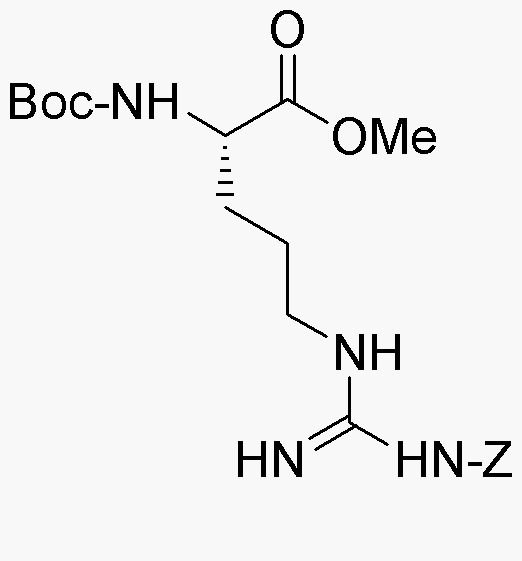Na-Boc-Nw-Z-L-arginine is widely utilized in research focused on:
- Peptide Synthesis: This compound serves as a key building block in the synthesis of peptides, particularly those that require protection of the arginine side chain. Its Boc (tert-butoxycarbonyl) group allows for selective deprotection, facilitating the formation of complex peptide structures.
- Drug Development: In pharmaceutical research, it plays a crucial role in developing peptide-based drugs. Its ability to enhance stability and bioavailability makes it a valuable candidate for therapeutic applications.
- Bioconjugation: The compound is used in bioconjugation processes, where it helps attach biomolecules to surfaces or other molecules, enhancing the functionality of diagnostic tools and drug delivery systems.
- Research in Molecular Biology: Researchers utilize this chemical in studies involving protein interactions and modifications, aiding in the understanding of cellular mechanisms and the development of targeted therapies.
- Custom Synthesis Services: Many chemical suppliers offer custom synthesis services for this compound, allowing researchers to obtain tailored derivatives that meet specific experimental needs, thus streamlining their research processes.
General Information
Properties
Safety and Regulations
Applications
Na-Boc-Nw-Z-L-arginine is widely utilized in research focused on:
- Peptide Synthesis: This compound serves as a key building block in the synthesis of peptides, particularly those that require protection of the arginine side chain. Its Boc (tert-butoxycarbonyl) group allows for selective deprotection, facilitating the formation of complex peptide structures.
- Drug Development: In pharmaceutical research, it plays a crucial role in developing peptide-based drugs. Its ability to enhance stability and bioavailability makes it a valuable candidate for therapeutic applications.
- Bioconjugation: The compound is used in bioconjugation processes, where it helps attach biomolecules to surfaces or other molecules, enhancing the functionality of diagnostic tools and drug delivery systems.
- Research in Molecular Biology: Researchers utilize this chemical in studies involving protein interactions and modifications, aiding in the understanding of cellular mechanisms and the development of targeted therapies.
- Custom Synthesis Services: Many chemical suppliers offer custom synthesis services for this compound, allowing researchers to obtain tailored derivatives that meet specific experimental needs, thus streamlining their research processes.
Documents
Safety Data Sheets (SDS)
The SDS provides comprehensive safety information on handling, storage, and disposal of the product.
Product Specification (PS)
The PS provides a comprehensive breakdown of the product’s properties, including chemical composition, physical state, purity, and storage requirements. It also details acceptable quality ranges and the product's intended applications.
Certificates of Analysis (COA)
Search for Certificates of Analysis (COA) by entering the products Lot Number. Lot and Batch Numbers can be found on a product’s label following the words ‘Lot’ or ‘Batch’.
*Catalog Number
*Lot Number
Certificates Of Origin (COO)
This COO confirms the country where the product was manufactured, and also details the materials and components used in it and whether it is derived from natural, synthetic, or other specific sources. This certificate may be required for customs, trade, and regulatory compliance.
*Catalog Number
*Lot Number
Safety Data Sheets (SDS)
The SDS provides comprehensive safety information on handling, storage, and disposal of the product.
DownloadProduct Specification (PS)
The PS provides a comprehensive breakdown of the product’s properties, including chemical composition, physical state, purity, and storage requirements. It also details acceptable quality ranges and the product's intended applications.
DownloadCertificates of Analysis (COA)
Search for Certificates of Analysis (COA) by entering the products Lot Number. Lot and Batch Numbers can be found on a product’s label following the words ‘Lot’ or ‘Batch’.
*Catalog Number
*Lot Number
Certificates Of Origin (COO)
This COO confirms the country where the product was manufactured, and also details the materials and components used in it and whether it is derived from natural, synthetic, or other specific sources. This certificate may be required for customs, trade, and regulatory compliance.


